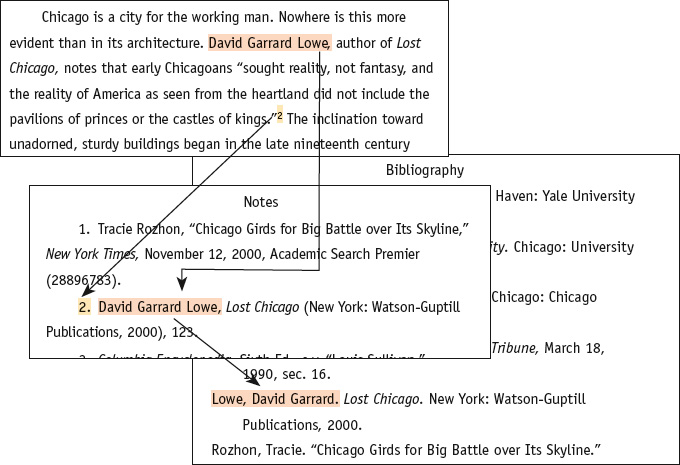54aThe basics of Chicago style
Why does academic work call for very careful citation practices when writing for the general public may not? The answer is that readers of academic work expect to get certain information from source citations:
- Source citations demonstrate that you’ve done your homework on your topic or issue and that you are a part of the conversation surrounding it.
- Source citations show that you understand the need to give credit where credit is due when you make use of someone else’s intellectual property. (See Chapter 18 for more details.)
- Source citations give explicit directions to guide readers who want to look for themselves at the works you’re using.
Guidelines from The Chicago Manual of Style will tell you exactly what information you need to include in your citation and how you should format that information.
TYPES OF SOURCES
You will need to be careful to tell your readers whether you read a print version or a digital version of a source that consists mainly of written words. Digital magazine and newspaper articles may include updates or corrections that the print version lacks; digital books may not number pages or screens the same way the print book does. If you are citing a source that has important media elements—such as a film, song, or artwork—consult the “Other Sources” section of the directory. And if you can’t find a model exactly like the source you’ve selected, see the box.
ARTICLES FROM WEB AND DATABASE SOURCES
You need a subscription to look through most databases, so individual researchers almost always gain access to articles in databases through the computer system of a school or community library that pays to subscribe. The easiest way to tell whether a source comes from a database, then, is that its information is not generally available free to anyone with an Internet connection. Many databases are digital collections of articles that originally appeared in edited print periodicals, ensuring that an authority has vouched for the accuracy of the information. Such sources often have more credibility than much of what you find free on the Web.
Connecting parts of citations
Citations in Chicago style appear in three places in your text—a note number in the text marks the material from the source, a footnote or an endnote includes information to identify the source (or information about supplemental material), and the bibliography provides the full citation.
Use superscript numbers (1) to mark citations in the text. Place the superscript for each note after the relevant quotation, sentence, clause, or phrase. Type the number after any punctuation mark except the dash, and do not leave space before the superscript. Number citations sequentially throughout the text. When you use signal phrases to introduce quotations or other source material, note that Chicago style requires you to use the present tense (citing Bebout’s studies, Meier points out).

Type footnotes at the bottom of the page on which the superscript appears; type endnotes on a separate page at the end under the heading Notes. (Check which your instructor prefers.) The first line of each note is indented one-half inch and begins with a number, a period, a space, and the name of the source’s author. All remaining lines of the entry are flush with the left margin. Footnotes and endnotes should be single-spaced, with a double space between notes, unless your instructor prefers double-spaced notes.
IN THE TEXT
Sweig argues that Castro and Che Guevara were not the only key players in the Cuban Revolution of the late 1950s.19
IN THE FIRST NOTE REFERRING TO THE SOURCE
19. Julia Sweig, Inside the Cuban Revolution (Cambridge, MA: Harvard University Press, 2002), 9.
After giving complete information the first time you cite a work, shorten additional references to that work: list only the author’s last name, a comma, a short version of the title, a comma, and the page number. If you refer to the same source cited in the previous note, you can use the Latin abbreviation Ibid. (“in the same place”) instead of the name and title.
IN FIRST AND SUBSEQUENT NOTES
19. Julia Sweig, Inside the Cuban Revolution (Cambridge, MA: Harvard University Press, 2002), 9.
20. Ibid., 13.
21. Ferguson, “Comfort of Being Sad,” 63.
22. Sweig, Cuban Revolution, 21.
The alphabetical list of the sources in your text is usually titled Bibliography in Chicago style. You may instead use the title Sources Consulted, Works Cited, or Selected Bibliography if it better describes your list.
In the bibliographic entry, include the same information as in the first note for that source, but omit the page reference. Give the first author’s last name first, followed by a comma and the first name; separate the main elements of the entry with periods rather than commas; and do not enclose the publication information for books in parentheses.
IN THE BIBLIOGRAPHY
Sweig, Julia. Inside the Cuban Revolution. Cambridge, MA: Harvard University Press, 2002.
Start the bibliography on a separate page after the main text and any notes. Continue the consecutive numbering of pages. Center the title Bibliography (without italics or quotation marks). The Chicago Manual of Style recommends single-spacing entries and double-spacing between entries.